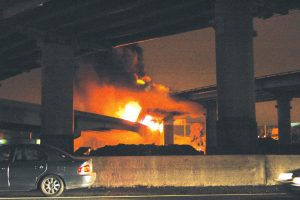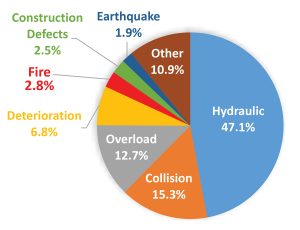Recent events have repeatedly reminded the engineering community that our transportation infrastructure is susceptible to fire from crashed or overturned vehicles, especially from trucks carrying flammable cargo. Despite these hazards, most bridges in the U.S. are designed and maintained with little, if any, consideration for fire resistance. With approximately 600,000 bridges currently in use in the U.S., fire has caused bridge failures at a rate consistent with other hazards to which engineers dedicate significant amounts of time and money to mitigate. A recent study from the State University of New York at Buffalo surveyed 1,062 bridge failures across the U.S. between 1980 and 2012 (Lee et al., 2013). As shown in Figure 1, common hazards such as flooding, collision, and overload constitute the majority of bridge failures; however, fire causes failure at a rate at least comparable to or exceeding those due to earthquake or construction defects, both of which are extensively addressed via design and inspection.
Tanker trucks carrying gasoline and diesel have contributed to most of the recent severe bridge fire events, including the total collapse of two spans in the MacArthur Maze I-80//I-580/I-880 interchange overpass in Oakland, CA, in 2007 (Figure 2). Also of concern are flammable materials that are stored underneath bridges, as was the case for the very recent total collapse of an I-85 overpass in Atlanta, GA in March 2017, when a large quantity of HDPE pipe caught fire under the bridge.

Figure 2. 2007 tanker truck fire at the MacArthur Maze freeway interchange near Oakland, CA. Courtesy of Philip Liborio Gangi, (https://bit.ly/2HxzI2w).
Fire incidents for long-span bridges include a 2014 fire of a cargo truck on the deck of the Zakim Bridge in Boston, as well as several incidents of single car fires on major bridges in New York City. Fortunately, these fires have generally resulted in minor to moderate structural damage with no collapse, since the fires were relatively small compared to those from tanker trucks. Since most long-span bridges do not restrict the transport of fuel and other hazardous cargo on their roadways, recent infrastructure projects have increasingly specified design scenarios that include tanker truck fires as part of a Threat, Vulnerability, and Risk Assessment (TVRA).
Fire is not explicitly addressed in the current AASHTO bridge design criteria (AASHTO, 2017), nor is it in most state DOT bridge design manuals. At best, wildfire exposure is briefly mentioned as a consideration in some state DOT documents such as those from Caltrans (2017), but the tanker and cargo truck design scenarios are not directly addressed. The most significant guidance is provided by NFPA 502, which addresses the design of both bridges and tunnels for fire exposure (NFPA 2017). According to Chapter 6 of that standard, the primary structural elements of bridges or elevated highways shall be protected to achieve the following functional requirements: 1) support firefighter accessibility; 2) mitigate structural damage and prevent progressive collapse; and 3) minimize economic impact. The document also states that an “engineering analysis” is needed to determine whether the collapse of the bridge due to fire would have adverse impacts to life safety or other unacceptable implications. The analyst should determine a design fire size and heat release produced by vehicles near or under the bridge. For truss or cable supported bridges, engineering analysis is explicitly required. While the type of “engineering analysis” is not defined, its results would presumably determine the acceptable risk due to fire, including possible collapse scenarios. However, little guidance is provided regarding the available approaches and performance objectives for such an analysis. The document also states that its design provisions only apply for bridges more than 1000 feet (300 m) in length, although most of the overpasses that have collapsed in the last 15 years have lengths under this cutoff. The standard is also unclear as to whether the 1000 feet corresponds to the total length of elevated highway or just the length of each span.
Going forward, there have been several recent studies which have proposed new methods to evaluate the risk, vulnerability, and consequence of a bridge failure based on bridge characteristics, location, and traffic load (Naser and Kodur, 2015). Approaches such as these can help owners and consultants determine where mitigation may be warranted beyond the simplistic 1000-foot length cutoff in NFPA 502. The “engineering analysis” of a bridge’s response to a vehicle-based fire hazard would then consist of four steps (Quiel et al., 2015):
- Determine the fire’s characteristics: The analyst should determine the fuel source as well as the fire’s potential footprint, flame height, and intensity. This step will produce a heat release rate, duration, and fire geometry.
- Calculate the heat transfer from the fire to the structural elements: The analyst should carefully consider how the fire is oriented toward the structural elements. If directly underneath, the flames and smoke plume may engulf the elements and provide both radiative and convective heat transfer. If the fire is adjacent to the elements but not underneath or engulfing them, radiation from the flame and smoke will be the primary mode of heat transfer.
- Calculate the temperature increase of the structural elements: The analyst should determine how much of the element’s surface area is exposed to fire. Convective and radiative heat transfer modes can be considered separately depending on how that element can “view” the fire. Heat balance equations, some of them straightforward and relying on lumped mass assumptions, can be used to calculate the time history of temperature increase for each element.
- Calculate the material and mechanical response of the bridge structure: The material properties of the fire-exposed elements will diminish as their temperature increases – these relationships can be obtained from multiple references. These material performance time histories can then be coupled with a structural analysis which considers in-situ loading, thermal expansion, and potential load redistribution.
The results of this methodology can be used to develop fire mitigation strategies for bridge structures. The further development of tools to fulfill the “engineering analysis” of NFPA 502 and the performance objectives of bridge owners remains an ongoing need for the structural design community.▪
References
AASHTO (2017). LRFD Bridge Design Specification, 8th Edition. American Association of State Highway and Transportation Officials, Washington, DC.
Caltrans (2017). Highway Design Manual, 6th Edition. California Department of Transportation, Sacramento, CA.
Lee, G.C., Mohan, S.B., Huang, C., Fard, B.N. (2013). Technical Report MCEER-13-008: A Study of US Bridge Failures (1980-2012). MCEER, University at Buffalo (SUNY), Buffalo, NY.
Naser, M.Z., Kodur, V.K.R. (2015). “A probabilistic assessment for classification of bridge against fire hazard.” Fire Safety Journal, Vol. 76, pp. 65-73.
NFPA (2017). NFPA 502: Standard for road tunnels, bridges, and other limited access highways, 2017 Edition. National Fire Protection Association, Quincy, MA.
Quiel, S.E., Yokoyama, T., Bregman, L.S., Mueller, K.A., Marjanishvili, S.M. (2015). “streamlined framework and case study for calculating the response of bridges to open-air tanker truck fires.” Fire Safety Journal, Vol. 73, pp. 63-75.

